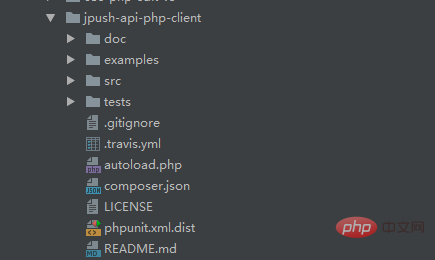Maison >développement back-end >tutoriel php >Le framework Yii1.1 simule la notification de message push PHP Aurora
Le framework Yii1.1 simule la notification de message push PHP Aurora
- little bottleavant
- 2019-04-25 14:23:402536parcourir
Cet article parle principalement de l'utilisation du framework Yii pour simuler la notification de message push PHP Aurora. Il a une certaine valeur de référence. Les amis intéressés peuvent en apprendre davantage.
1. Téléchargez le SDK PHP Aurora Push, décompressez-le et placez-le dans le répertoire /protected/components/, comme indiqué ci-dessous :

2. Améliorer les modifications Prenons l'exemple de la démo officielle. Je copie une démo ici et la change en NotifyPush.php, avec le code suivant :
<?php
require dirname(__FILE__) . '/jpush-api-php-client/autoload.php';
use JPush\Client as JPush;
class NotifyPush {
static function pushAlias($alias,$ticket='消息提醒',$alert){
$appKey=Yii::app()->params['push']['AppKey'];
$appMasterSecret=Yii::app()->params['push']['AppMasterSecret'];
$production_mode=Yii::app()->params['push']['production_mode'];
$client = new JPush($appKey, $appMasterSecret);
// 完整的推送示例
// 这只是使用样例,不应该直接用于实际生产环境中 !!
try {
$response = $client->push()
->setPlatform(array('ios', 'android'))
// 一般情况下,关于 audience 的设置只需要调用 addAlias、addTag、addTagAnd 或 addRegistrationId
// 这四个方法中的某一个即可,这里仅作为示例,当然全部调用也可以,多项 audience 调用表示其结果的交集
// 即是说一般情况下,下面三个方法和没有列出的 addTagAnd 一共四个,只适用一个便可满足大多数的场景需求
->addAlias($alias)
->setNotificationAlert($alert)
->iosNotification($ticket, array(
'sound' => 'sound.caf',
// 'badge' => '+1',
// 'content-available' => true,
// 'mutable-content' => true,
'category' => 'jiguang',
'extras' => array(
'key' => 'value',
'jiguang'
),
))
->androidNotification($ticket, array(
'title' => $alert,
// 'build_id' => 2,
'extras' => array(
'key' => 'value',
'jiguang'
),
))
->message($alert, array(
'title' => $alert,
// 'content_type' => 'text',
'extras' => array(
'key' => 'value',
'jiguang'
),
))
->options(array(
// sendno: 表示推送序号,纯粹用来作为 API 调用标识,
// API 返回时被原样返回,以方便 API 调用方匹配请求与返回
// 这里设置为 100 仅作为示例
// 'sendno' => 100,
// time_to_live: 表示离线消息保留时长(秒),
// 推送当前用户不在线时,为该用户保留多长时间的离线消息,以便其上线时再次推送。
// 默认 86400 (1 天),最长 10 天。设置为 0 表示不保留离线消息,只有推送当前在线的用户可以收到
// 这里设置为 1 仅作为示例
// 'time_to_live' => 1,
// apns_production: 表示APNs是否生产环境,
// True 表示推送生产环境,False 表示要推送开发环境;如果不指定则默认为推送生产环境
'apns_production' => $production_mode,
// big_push_duration: 表示定速推送时长(分钟),又名缓慢推送,把原本尽可能快的推送速度,降低下来,
// 给定的 n 分钟内,均匀地向这次推送的目标用户推送。最大值为1400.未设置则不是定速推送
// 这里设置为 1 仅作为示例
// 'big_push_duration' => 1
))
->send();
print_r($response);
} catch (\JPush\Exceptions\APIConnectionException $e) {
// try something here
print $e;
} catch (\JPush\Exceptions\APIRequestException $e) {
// try something here
print $e;
}
}
static function pushAll($ticket='消息提醒',$alert){
$appKey=Yii::app()->params['push']['AppKey'];
$appMasterSecret=Yii::app()->params['push']['AppMasterSecret'];
$production_mode=Yii::app()->params['push']['production_mode'];
$client = new JPush($appKey, $appMasterSecret);
// 完整的推送示例
// 这只是使用样例,不应该直接用于实际生产环境中 !!
try {
$response = $client->push()
->setPlatform(array('ios', 'android'))
->setAudience('all')
// 一般情况下,关于 audience 的设置只需要调用 addAlias、addTag、addTagAnd 或 addRegistrationId
// 这四个方法中的某一个即可,这里仅作为示例,当然全部调用也可以,多项 audience 调用表示其结果的交集
// 即是说一般情况下,下面三个方法和没有列出的 addTagAnd 一共四个,只适用一个便可满足大多数的场景需求
->setNotificationAlert($alert)
->iosNotification($ticket, array(
'sound' => 'sound.caf',
// 'badge' => '+1',
// 'content-available' => true,
// 'mutable-content' => true,
'category' => 'jiguang',
'extras' => array(
'key' => 'value',
'jiguang'
),
))
->androidNotification($ticket, array(
'title' => $alert,
// 'build_id' => 2,
'extras' => array(
'key' => 'value',
'jiguang'
),
))
->message($alert, array(
'title' => $alert,
// 'content_type' => 'text',
'extras' => array(
'key' => 'value',
'jiguang'
),
))
->options(array(
// sendno: 表示推送序号,纯粹用来作为 API 调用标识,
// API 返回时被原样返回,以方便 API 调用方匹配请求与返回
// 这里设置为 100 仅作为示例
// 'sendno' => 100,
// time_to_live: 表示离线消息保留时长(秒),
// 推送当前用户不在线时,为该用户保留多长时间的离线消息,以便其上线时再次推送。
// 默认 86400 (1 天),最长 10 天。设置为 0 表示不保留离线消息,只有推送当前在线的用户可以收到
// 这里设置为 1 仅作为示例
// 'time_to_live' => 1,
// apns_production: 表示APNs是否生产环境,
// True 表示推送生产环境,False 表示要推送开发环境;如果不指定则默认为推送生产环境
'apns_production' => $production_mode,
// big_push_duration: 表示定速推送时长(分钟),又名缓慢推送,把原本尽可能快的推送速度,降低下来,
// 给定的 n 分钟内,均匀地向这次推送的目标用户推送。最大值为1400.未设置则不是定速推送
// 这里设置为 1 仅作为示例
// 'big_push_duration' => 1
))
->send();
print_r($response);
} catch (\JPush\Exceptions\APIConnectionException $e) {
// try something here
print $e;
} catch (\JPush\Exceptions\APIRequestException $e) {
// try something here
print $e;
}
}
}3. Appelez la méthode dans NotifyPush.php pour implémenter le push, comme suit :
class CronNotifyPushCommand extends CConsoleCommand{
public $keys=array();
public function init(){
parent::init();
}
public function actionIndex(){
echo 'start CronNotifyPushCommand '.chr(10);
if(!Yii::app()->params['push']['push_status']){
echo 'push status disabled';die();
}
$rkey='message_notify_list';
$waitTotals=Fredis::model()->redis->lsize($rkey);
echo 'wait totals:'.$waitTotals.chr(10);
$waitResult=true;
$i=0;
while($waitResult) {$i++;
echo $i.'/'.$waitTotals.' wait to do'.chr(10);
$waitResult=Fredis::model()->redis->rpop($rkey);
if(!$waitResult) {
continue;
}
$db_data=unserialize($waitResult);var_dump($db_data);
$message_content=$db_data['message_content'];
$uid=$db_data['uid'];
$alias=$uid;
if($uid==0){
NotifyPush::pushAll($message_content, $message_content);
}else {
NotifyPush::pushAlias($alias, $message_content, $message_content);
}
}
echo 'end'.chr(10);
}
}
Tutoriels associés : Tutoriel vidéo PHP
Ce qui précède est le contenu détaillé de. pour plus d'informations, suivez d'autres articles connexes sur le site Web de PHP en chinois!

